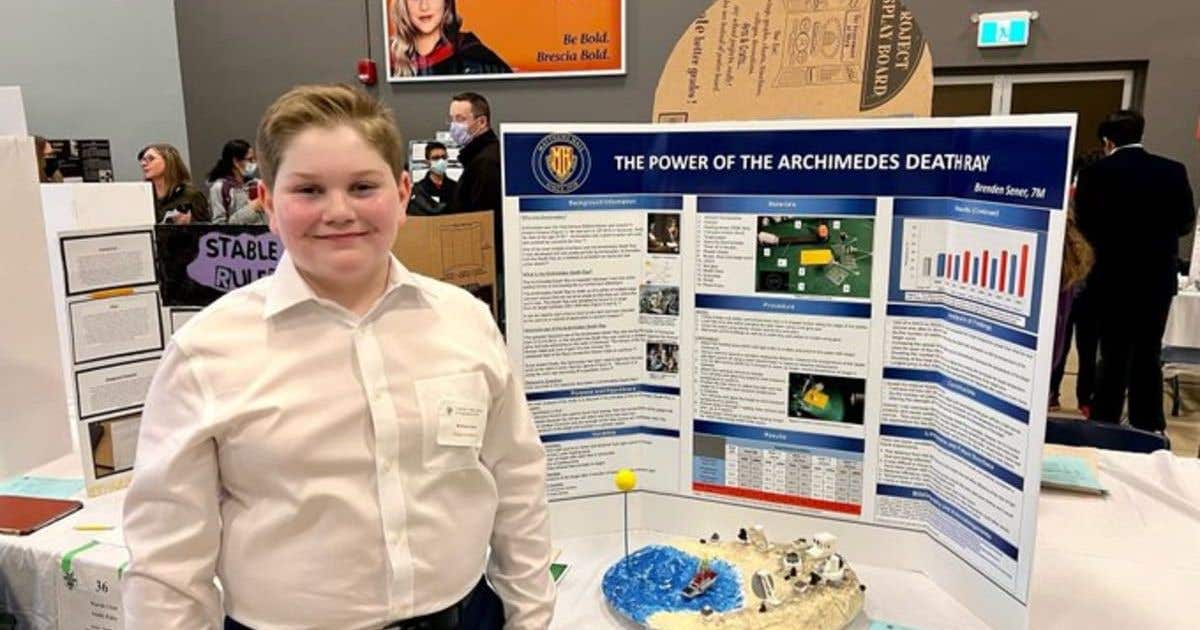13-year-old built a functional ‘death ray’ using a 2,000-year-old concept from Archimedes
Middle school student Brenden Sener devised a science fair project aimed at replicating a miniature version of the so-called “death ray”.

Middle school student Brenden Sener devised a science fair project aimed at replicating a miniature version of the so-called "death ray". (CREDIT: Facebook | Matthews Hall)
For centuries, legends surrounding the brilliance of the Greek polymath Archimedes have persisted, including the notion that he utilized mirrors to set fire to Roman ships over two millennia ago.
This enduring tale intrigued many scholars, captivating imaginations with its portrayal of remarkable ingenuity.
Canadian middle school student Brenden Sener embarked on a scientific exploration to investigate the plausibility of this ancient feat. Inspired by Archimedes' purported invention, he devised a science fair project aimed at replicating a miniature version of the so-called "death ray."
While Sener's objective wasn't to ignite objects, his experimental setup, employing heat lamps and mirrors, notably elevated the temperature of the target.
Related Stories
Reflecting on his findings, the 13-year-old concluded that with scaling up and employing a sufficiently potent heat source, Archimedes' concept could indeed hold merit. Sener shared with reporters, "If it was scaled up and with a strong enough heat source, it would definitely be possible."
Sener's fascination with Archimedes was sparked by encountering the Archimedes screw in a documentary. This initial curiosity led him to delve deeper into the renowned mathematician's inventions, eventually uncovering the enigmatic "death ray."
During the historical siege of Syracuse between 214 and 212 BC, Roman general Marcus Claudius Marcellus endeavored to conquer the island of Sicily. Accounts from the 12th century, notably Joannes Zonaras' writings, describe Archimedes' purported use of a mirror-like device to unleash destruction upon the Roman fleet by harnessing the power of the sun.
Experimental Setup. 1) Infrared thermometer, 2) Clamps, 3) Heating lamps (50W, 100W), 4) Concave mirrors (four), 5) Target paper, 6) Stand for thermometer, 7) Timer of 3 minutes. (CREDIT: CSF Journal)
In Sener's scaled-down rendition, heat lamps represented the sun, while small concave mirrors directed the light towards a marked target on a cardboard surface. Through meticulous experimentation, Sener measured temperature increases with each additional mirror, showcasing the potential efficacy of Archimedes' concept.
Numerous attempts to replicate the "death ray" have been made over the years, yielding varying degrees of success. Notably, the popular TV show "Mythbusters" made multiple endeavors to recreate the phenomenon, albeit without success. Despite these challenges, the allure of Archimedes' invention has persisted throughout history, captivating the attention of thinkers and experimenters across different eras.
Sample of experimental setup. (CREDIT: CSF Journal)
Renowned figures like René Descartes and Athanasius Kircher expressed skepticism regarding the feasibility of the death ray. However, experiments by individuals such as Georges-Louis Leclerc and Ioannis Sakkas provided tantalizing glimpses into the potential effectiveness of Archimedes' invention.
Critics and historians have highlighted alternative methods available to Archimedes during the siege, suggesting that steam cannons or incendiary mixtures may have been more practical options for repelling the Roman fleet. Additionally, the possibility of using mirrors for strategic dazzlement rather than fiery destruction adds complexity to the historical narrative surrounding Archimedes' alleged invention.
The effect of increasing the number of mirrors to focus energy after 3 minutes of heating using 50W (blue) and 100W (red) heat sources on the average temperature of the target compared to baseline temperature (grey). (CREDIT: CSF Journal)
Despite the uncertainties surrounding the ancient legend, Sener's project garnered recognition for its role in fostering scientific curiosity and interest among students.
The tests showed that the idea behind the Archimedes Death Ray could actually work and that Sener's original guess was correct: curved mirrors can focus and intensify light from a light source.
Athanasius Kircher made an engraving showing how Archimedes' burning mirrors might have been used. (CREDIT: Bettmann via Getty Images)
The historical descriptions of the use of the Death Ray in ancient Syracuse is plausible, however no archeological evidence of the Archimedes Death ray has been found besides what is recorded in the books of Ancient Philosophers.
Reflecting on his achievement, he expressed gratitude for the acknowledgment received from the London Public Library, underscoring the value of inspiring future generations in the pursuit of science and technology.
Note: Materials provided above by The Brighter Side of News. Content may be edited for style and length.
Like these kind of feel good stories? Get the Brighter Side of News' newsletter.
Joshua Shavit
Science & Technology Writer | AI and Robotics Reporter
Joshua Shavit is a Los Angeles-based science and technology writer with a passion for exploring the breakthroughs shaping the future. As a contributor to The Brighter Side of News, he focuses on positive and transformative advancements in AI, technology, physics, engineering, robotics and space science. Joshua is currently working towards a Bachelor of Science in Business Administration at the University of California, Berkeley. He combines his academic background with a talent for storytelling, making complex scientific discoveries engaging and accessible. His work highlights the innovators behind the ideas, bringing readers closer to the people driving progress.



